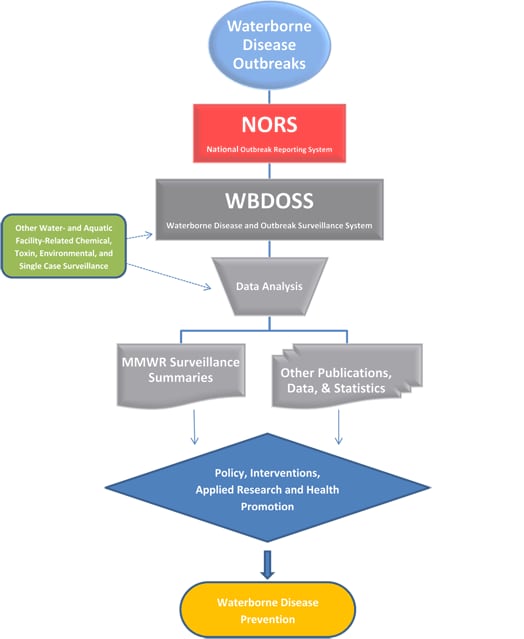Systems for Tracking Waterborne Disease and Outbreaks
The Waterborne Disease and Outbreak Surveillance System (WBDOSS) collects data on waterborne disease and outbreaks associated with recreational water, drinking water, and environmental and undetermined exposures to water.
WBDOSS is a national surveillance system started in 1971 as a partnership between CDC, the Council of State and Territorial Epidemiologists (CSTE), and the U.S. Environmental Protection Agency (EPA). The system depends on health departments in states, territories, and the Freely Associated States to provide complete and accurate data for waterborne disease and outbreaks.
WBDOSS was initially designed to collect data on drinking water outbreaks in the United States. It expanded to capture outbreaks associated with recreational water and other environmental and undetermined exposures to water. Annual or biennial surveillance reports of its data have been published in CDC reports from 1971 to 1984 and in the Morbidity and Mortality Weekly Report (MMWR) from 1985 to the present.
Data from WBDOSS have supported many efforts to reduce waterborne disease outbreaks. The data shaped EPA efforts to develop drinking water regulations and guided CDC’s recreational water activities, such as the Healthy Swimming program and the national Model Aquatic Health Code. Data from WBDOSS has highlighted the emergence of Legionella outbreaks over time and identified a variety of exposures and settings in these outbreaks (e.g., drinking water or environmental exposure to water; long term care facilities, large buildings), allowing targeted prevention efforts. Waterborne outbreak reporting to WBDOSS transitioned from a paper-based process to an electronic process in 2009. Outbreaks are now reported to CDC via the National Outbreak Reporting System (NORS).
Single cases of disease, some of which can be transmitted by water, are reported by health departments to the National Notifiable Disease Surveillance System.
Other data used to prevent waterborne disease and outbreaks include:
- Aquatic facility-related health events not associated with recreational water, which are reported occasionally by jurisdictional health officials
- Single cases of illness associated with water (e.g., primary amebic meningoencephalitis caused by Naegleria fowleri, chemical/toxin poisoning, and wound infections), are reported occasionally by jurisdictional health officials
- Single cases of recreational water-associated Vibrio are reported separately to the Cholera and Other Vibrio Surveillance System (COVIS)
